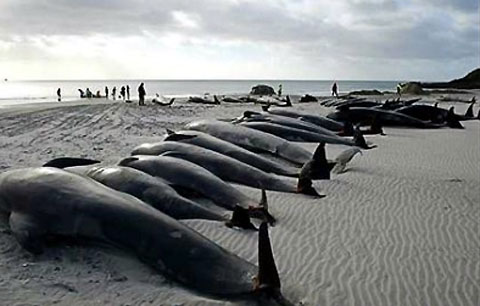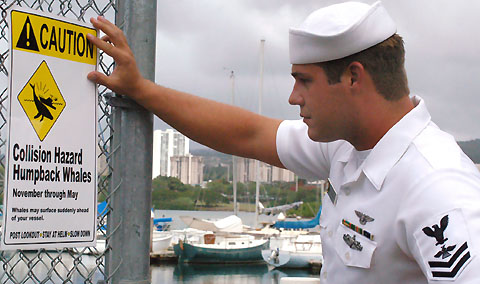by Paul Achitoff & Marsha Green on 16 May 2007 at Earthjustice.org
Conservation and animal welfare organizations today filed in Hawai'i federal district court a legal challenge to the U.S. Navy's plan to use high-intensity, mid-frequency active sonar in antisubmarine exercises in Hawai'i's waters. The planned sonar would emit blasts far louder than levels associated with mass whale strandings and fatalities.
The Navy has announced plans to use the sonar in up to twelve separate sets of Undersea Warfare Exercises (USWEXs) during 2007 and 2008 in Hawai'i's waters, including within the Hawaiian Islands Humpback Whale National Marine Sanctuary and near the Papaha¯naumokua¯kea Marine National Monument in the Northwestern Hawaiian Islands. Attorneys from Earthjustice filed suit in Hawai'i federal district court on behalf of Ocean Mammal Institute, the Animal
Welfare Institute, KAHEA, Center for Biological Diversity, and Surfrider Foundation.
Marti Townsend of KAHEA said, "The Navy is not above the law. Just the reverse-as a government agency, the Navy should be setting an example. Protecting the country includes following its laws, not skirting them."
NMFS, the agency responsible for protecting endangered marine life, relying almost entirely on the Navy's assessments, made little effort to analyze the sonar's effects or require the Navy to implement protective mitigation, such as that to which the Navy agreed for the 2006 RIMPAC exercises in Hawai'i. The plaintiffs have sued NMFS as well, for violating the Endangered Species Act.
The Animal Welfare Institute's Susan Millward commented, "It's disappointing that NMFS abdicated its responsibilities by allowing the Navy to decide for itself the mitigation it will use." Dr. Marsha Green of Ocean Mammal Institute added, "The Navy knows protecting whales is possible-it used more protective mitigation in the 2006 RIMPAC exercises than it plans to use in these."
Read the complaint online here:
http://www.earthjustice.org/library/legal_docs/complaint-against-navy-sonar-in-hawaii-05-16-07.pdf
Background
Hawai'i is well known as the winter breeding grounds for thousands of endangered humpback whales, but endangered blue, fin, Northern Pacific right, sei, and sperm whales also are found here, along with thousands of whales and dolphins of other species that will be exposed to the sonar. A whale's keen sense of hearing is vital in every aspect of its life history, including foraging for food, finding mates, bonding with offspring, communicating with other
members of their species, navigating through lightless waters, and avoiding predators. Exposure to sonar blasts can cause serious injury or death caused by hemorrhages or other tissue trauma, temporary and permanent hearing loss, displacement from preferred habitat, and disruption of feeding, breeding, nursing, communication, sensing and other behaviors essential to survival.
In July 2004, more than 150 melon-headed whales congregated in the shallow waters of Hanalei Bay, Kaua'i during the Navy's biennial RIMPAC exercises. The whales had to be herded back to open water by volunteers, and a young whale calf was found dead. The National Marine Fisheries Service (NMFS) concluded the Navy's sonar transmissions were a "plausible, if not likely, contributing factor to the animals entering and remaining in the bay." The Navy's
2006 RIMPAC war games were halted by a court-ordered temporary restraining order, and the Navy agreed to implement mitigation measures. The Navy has failed to include most of that mitigation in the upcoming exercises. The Navy's USWEX exercises will occur in addition to the 2008 RIMPAC war games.
Use of military sonar has been associated with strandings not only on Kaua'i, but in Greece (1996), the Bahamas (2000), Madeira (2000), Vieques (1998, 2002), the Canary Islands (2002, 2004), the northwest coast of the U.S. (2003), and Spain (2006). Necropsies performed on whales stranded in the Bahamas and the Canary Islands (2002) revealed hemorrhaging around the brain and in other organs, most likely due to acoustic trauma from the use of high intensity
sonar. The Navy itself concluded that for the Bahamas stranding "an acousticS¹ injuryS¹caused
the animals to strandS¹and subsequently dieS¹", and a report commissioned by the Navy stated that "the evidence of sonar causation [of whale beachings] is, in our opinion, completely convincing." In 2004 and 2005, whales and dolphins stranded or died on the coasts of Australia and New Zealand, North Carolina, and Florida after use of high intensity sonar. The Scientific Committee of the International Whaling Commission, the world's preeminent
body of scientists studying whale populations, has found that the evidence linking mid-frequency sonar to the mass strandings and deaths of whales appears "overwhelming."
The Navy acknowledged in its Environmental Assessment for the Hawai'i exercises that its sonar will reach whales at levels up to 215 dB-at least a hundred thousand times more intense than the levels at which the whales stranded in the Bahamas incident-and that the sonar will, at a minimum, likely significantly alter or cause the abandonment of the whales' migration, surfacing, nursing, feeding, or sheltering behaviors. Recognizing it will harm whales in
violation of the Marine Mammal Protection Act, the Navy in January 2007 exempted itself from that law. The Navy nonetheless refused to prepare an Environmental Impact Statement in violation of the National Environmental Policy Act, refused to include protective mitigation, and dismissed as insignificant the impacts to thousands of marine mammals, including humpbacks nursing calves in Hawai'i's protected nearshore waters. It also failed to comply with the
Coastal Zone Management Act and National Marine Sanctuaries Act.
contact :
Paul Achitoff - Earthjustice Hawaii at (808) 599-2436
Marsha Green - Ocean Mammal Institute at (610) 670-7386
Mark Palmer - International Marine Mammal Project at (415) 788-3666
see also:
Island Breath: Navy agrees to sonar precautions 7/9/2006
Island Breath: RIMPAC 2006 to begin 5/23/2006
Island Breath: Navy Whale Stranding 9/2/2004
|

